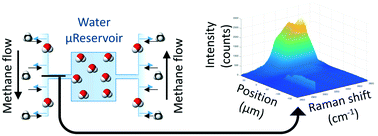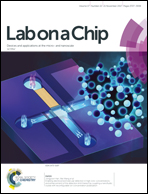Confined methane–water interfacial layers and thickness measurements using in situ Raman spectroscopy
Abstract
Gas–liquid interfaces broadly impact our planet, yet confined interfaces behave differently than unconfined ones. We report the role of tangential fluid motion in confined methane–water interfaces. The interfaces are created using microfluidics and investigated by in situ 1D, 2D and 3D Raman spectroscopy. The apparent CH4 and H2O concentrations are reported for Reynolds numbers (Re), ranging from 0.17 to 8.55. Remarkably, the interfaces are comprised of distinct layers of thicknesses varying from 23 to 57 μm. We found that rarefaction, mixture, thin film, and shockwave layers together form the interfaces. The results indicate that the mixture layer thickness (δ) increases with Re (δ ∝ Re), and traditional transport theory for unconfined interfaces does not explain the confined interfaces. A comparison of our results with thin film theory of air–water interfaces (from mass transfer experiments in capillary microfluidics) supports that the hydrophobicity of CH4 could decrease the strength of water–water interactions, resulting in larger interfacial thicknesses. Our findings help explain molecular transport in confined gas–liquid interfaces, which are common in a broad range of societal applications.



 Please wait while we load your content...
Please wait while we load your content...